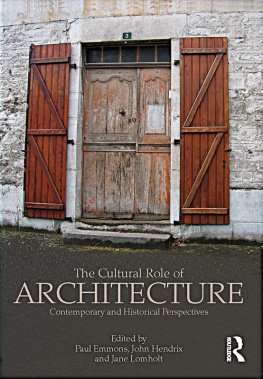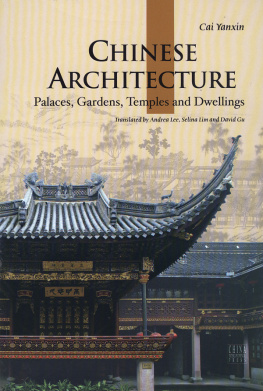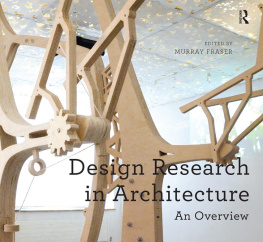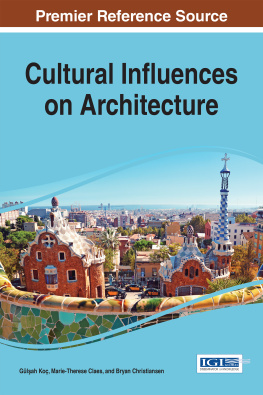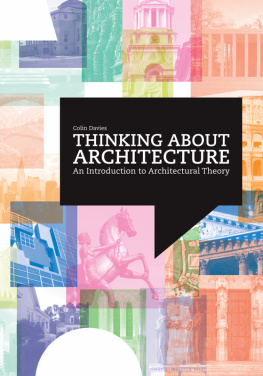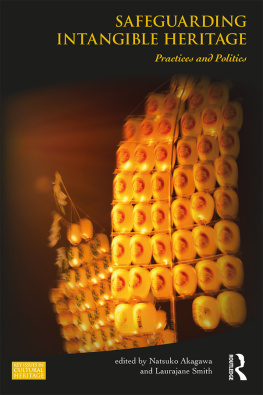The meaning of culture, as it pertains to both architectural discourse and production, is contested in the contemporary world. Whether considered through the lens of innovation or tradition, culture is the subject of intense debate in which conflicting claims are made about its accumulated meanings over time and its potential for advancing new directions in architectural theory.
Exploring the complexities of how we define the word culture in our global society, this book identifies its imprint on architectural ideas as well as architecture's role in cultural edification. Organized topically and historically, it examines the role of the cultural in architectural conception and production by looking at its profound and commonplace engagement as well as tracing the formations of cultural identities.
Chapters written by international academics in history, theory and philosophy of architecture, examine how different modes of representation throughout history have drawn profound meanings from cultural practices and beliefs. These are as diverse as the designs they inspire and include religious, mythic, poetic, political, and philosophical references.
This book establishes as crucial the role of contemporary architecture in mediating between ideas and values of a mass culture and the horizon of individual and collective experience.

LONDON AND NEW YORK
First published 2012
by Routledge
2 Park Square, Milton Park, Abingdon, Oxon OX14 4RN
Simultaneously published in the USA and Canada
by Routledge
711 Third Avenue, New York, NY 10017
Routledge is an imprint of the Taylor & Francis Group, an informa business
2012 selection and editorial material, Paul Emmons, John Hendrix and
Jane Lomholt; individual chapters, the contributors
The right of the editors to be identified as the authors of the editorial material, and of the authors for their individual chapters, has been asserted in accordance with sections 77 and 78 of the Copyright, Designs and Patents Act 1988.
All rights reserved. No part of this book may be reprinted or reproduced or utilised in any form or by any electronic, mechanical, or other means, now known or hereafter invented, including photocopying and recording, or in any information storage or retrieval system, without permission in writing from the publishers.
Trademark notice: Product or corporate names may be trademarks or registered trademarks, and are used only for identification and explanation without intent to infringe.
British Library Cataloguing in Publication Data
A catalogue record for this book is available from the British Library
Library of Congress Cataloging in Publication Data
The cultural role of architecture: contemporary and historical perspectives/
edited by Paul Emmons, John Hendrix & Jane Lomholt.
p. cm.
Includes bibliographical references and index.
1. Architecture and society. I. Emmons, Paul. II. Hendrix, John.
III. Lomholt, Jane.
NA2543.S6C79 2012
720.103dc23 2011033267
ISBN: 978-0-415-78340-8 (hbk)
ISBN: 978-0-415-78341-5 (pbk)
Typeset in Univers
by Florence Production Ltd, Stoodleigh, Devon
Contents
Nicholas Temple
Part One
Architecture as Agent of Recovery: A Testimony to Values
Jane Lomholt
Dagmar Motycka Weston
Chris Siwicki
Liana De Girolami Cheney
No Badillo
Jane Lomholt
Louise Pelletier
Cristina Gonzlez-Longo
Part Two
Architecture as Substance and Sustenance: Cultural Desires and Needs
Paul Emmons
Marco Frascari
Chris Hay
Harry Charrington
Jan Frohburg
Alexandra Stara
Paul Emmons
Gerald Adler
Part Three
A Time of Aspirations: Cultural Understanding of the Roles of Architecture
John Hendrix
Alberto Prez-Gmez
Nikolaos-Ion Terzoglou
Ashraf Salama
Jason Crow
Mark Cannata
Nader El-Bizri
John Hendrix
John Hendrix
Figures
Theatre of Epidaurus, c. 360 BC
Theatre spectators
Folk dancers at Delphi
Threshing floor near Bassae
Dionysos and satyr on a drinking cup
Thetis and Hephaestus with the armour of Achilles
The battle between Achilles and Hector
Dionysos as a mask on a column during the Lenaia dramatic festival
Maenad reveler
Dance of satyrs
Babylonian map of the world, 700-500 BC
Map of world according to Hecataeus of Miletus, c. 500 BC
God creating the world in the Bible moralise, thirteenth century
Theatre of Epidaurus, c. 360 BC, plan after von Gerkan
View of the Piazzale degli Uffizi (Vasari 1564), Uffizi, Florence
Corridoio Vasariano, view from the Arno River, Uffizi, Florence
View of the Vasari Corridor at the Uffizi: self-portraits of the artists hang on the walls, Uffizi, Florence
Reconstruction of Vasari's Uffizi in the shape of a Tau cross
Villa Albani site diagrams, from Nolli's Pianta Grande 1748 (left) and D. Magnan 17751776 (right) showing the change in acquisition and extent of property. Via Salaria runs north-south to the left of each plan
Villa Albani by Piranesi, 1761
Plan showing the relationship of Casino to Caffaus, the central and eastern arrangement of gardens with ancillary structures
Caryatids from the Erechtheion, Acropolis, Greece
tienne-Louis Boulle's buried architecture inspired by the winter season, entrance to a cemetery
Ground floor plan of Palazzo Barbarano, based on Burns and Beltramini (2008: 208215)
Ground floor plan of Palazzo Barberini, based on Borsi and Magnanimi (1983: 12) and Waddy (1990: 178)
Ground floor plan of Queensberry House
Historical view of Caff Pedrocchi, Padua. Architect: Giuseppe Jappelli
Diagrams of Platforms (left) and Roofs (right). 1: Villa Schreiner, Oslo (1963). 2: Nordic Pavilion, Venice (1962). 3: Norwegian Glacier Museum, Jostedal Glacier (1991). 4: Hedmark Museum, Domkirkeodden, Hamar (1969). 5: Ivar Aasen Centre (2000). Architect: Sverre Fehn
Venice Pavilion and Villa Schreiner. Architect: Sverre Fehn
Venice Pavilion (SEIER+SEIER). Architect: Sverre Fehn
Alvar Aalto, Rautatalo roof lenses, Helsinki, 19511957
Alvar Aalto, Rautatalo courtyard, Helsinki, 19511957
Alvar Aalto, Ahto Virtanen grave, Helsinki, 1937

